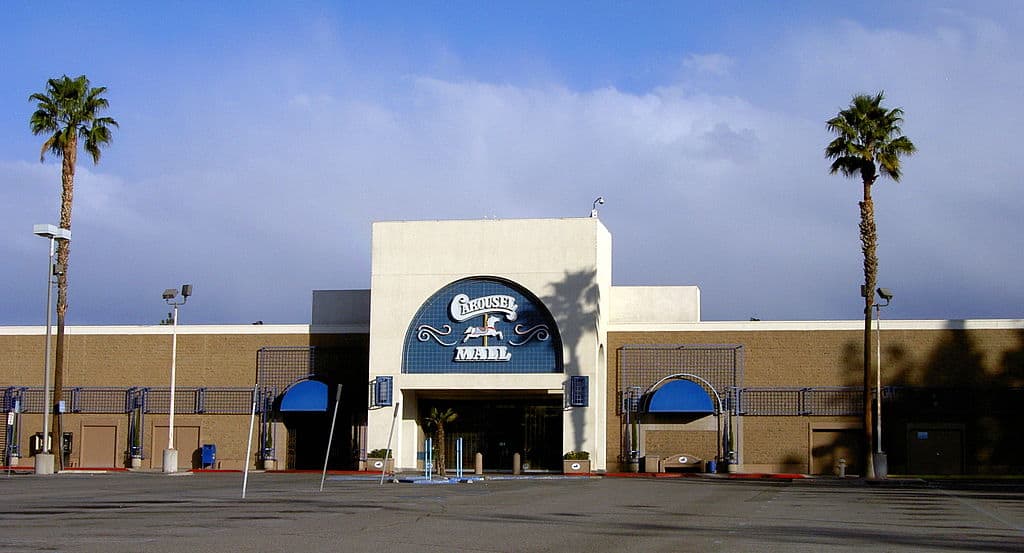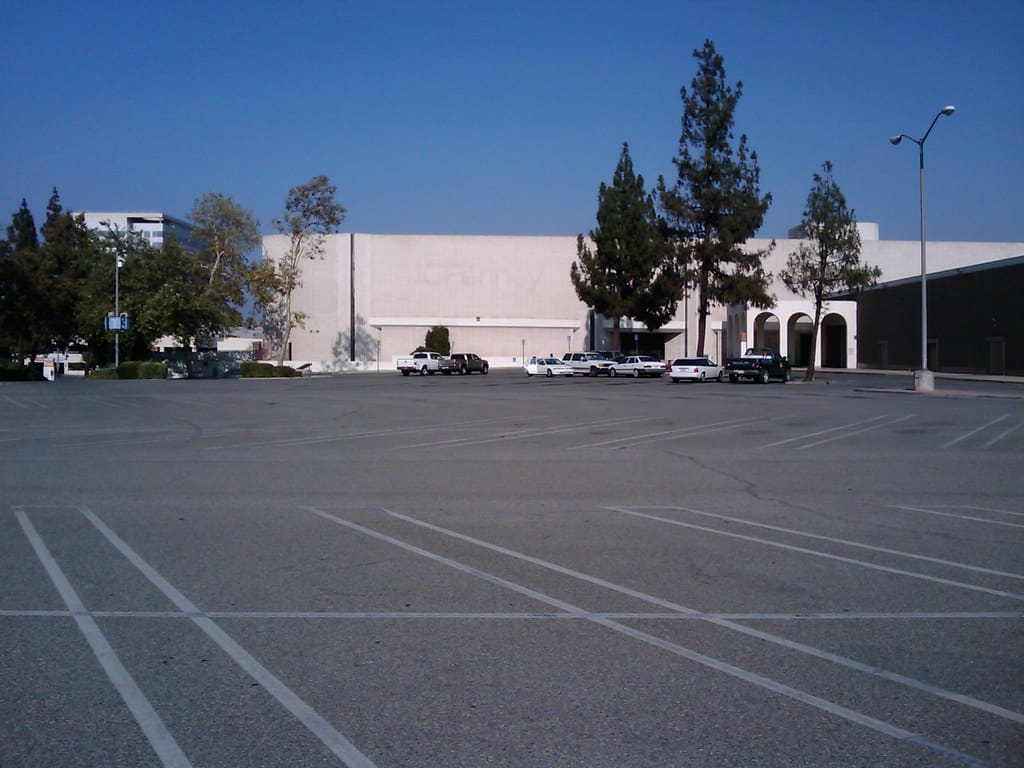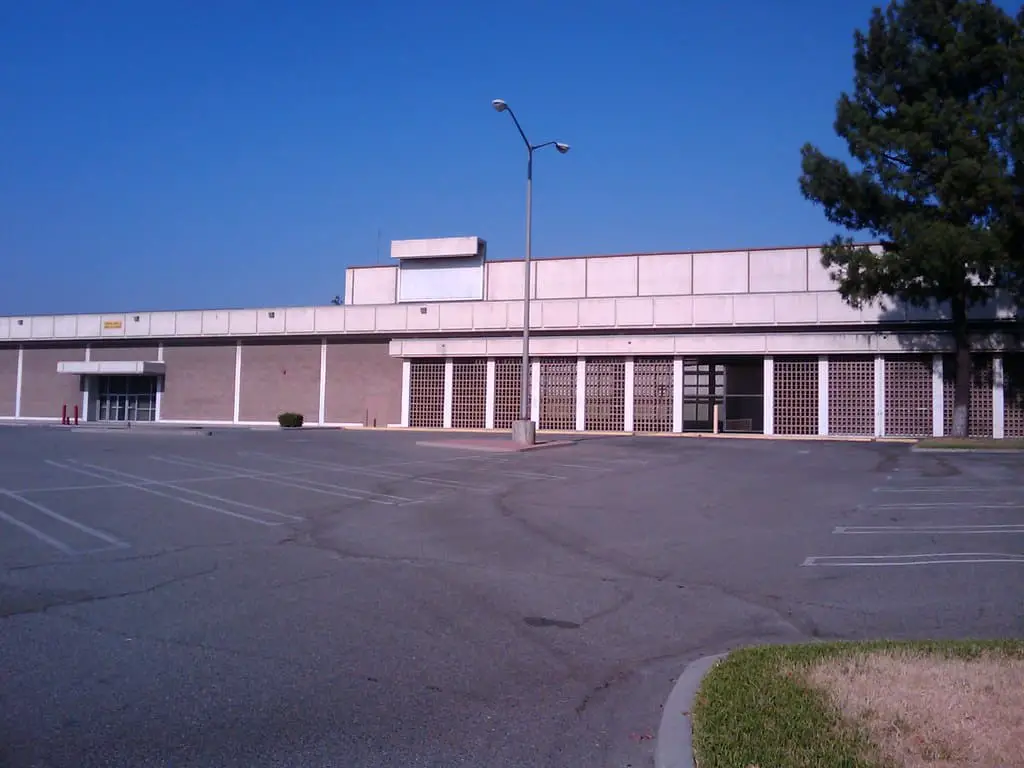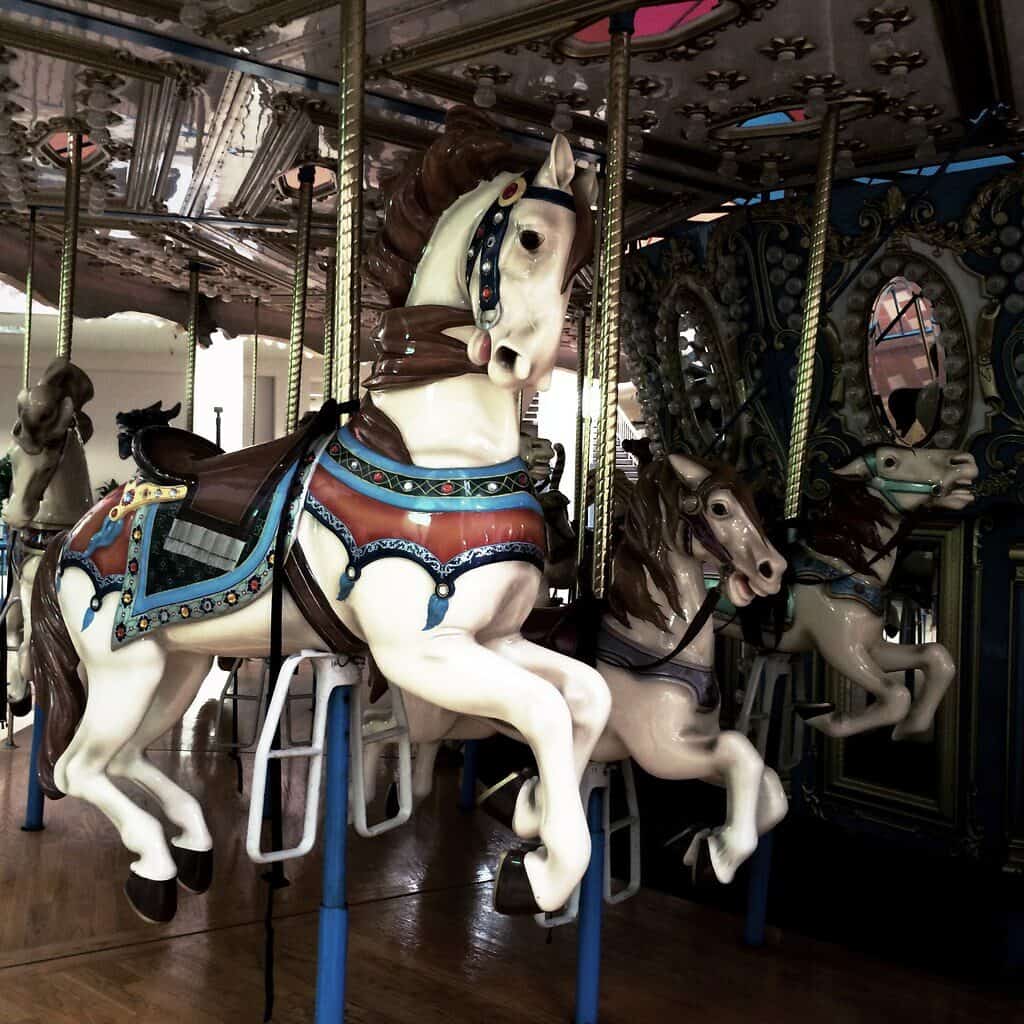The Birth of Carousel Mall
In the heart of San Bernardino, CA, a new landmark emerged on October 11, 1972. Known as Central City Mall, it was a two-story structure with 52 stores.
Three major anchor stores—Montgomery Ward, JCPenney, and The Harris Company—were the pillars of this shopping haven.
The mall was more than a shopping center; it was an urban renewal project to revitalize downtown San Bernardino.
The mall’s design was a spectacle in itself. With wide corridors and elegant storefronts, it was a place where families could spend an entire day.
The food court was a culinary delight, offering a variety of cuisines to satisfy every palate.
However, even in its early days, Central City Mall faced challenges. Local gangs started frequenting the area, and the mall’s management struggled to maintain order.
The city leaders and management companies changed hands, but the mall’s problems persisted.
Despite these issues, the mall remained a popular destination for shopping and socializing.
Seasonal events and promotions kept the foot traffic steady. For many, it was one of the go-to things in San Bernardino, California.
The Struggles of Central City Mall in the Late ’70s
The late ’70s were a challenging period for Central City Mall. Despite its initial success, the mall started to lose its appeal.
The local gangs that frequented the area became a significant concern, affecting the mall’s reputation and safety.
Different management companies tried to revive the mall, but none succeeded.
USA Quiz
How many questions would you like?
The city leaders were also at a loss, unable to turn the tide in the mall’s favor. The mall started to lose its luster, and the number of vacant stores rose.
Despite these challenges, the mall remained open. Seasonal events, such as Christmas fairs and summer carnivals, were organized to attract visitors.
However, these were short-term solutions and did little to address the underlying problems.

The mall’s decline was a local issue and reflected broader economic and social changes.
The rise of suburban shopping centers and changes in consumer behavior contributed to the mall’s struggles.
By the end of the 80s, it was clear that Central City Mall needed a significant overhaul.
The management decided to take drastic measures to revive the mall’s fortunes. This led to renovations and changes that would redefine the mall’s identity.
The mall’s future was uncertain, and many wondered if it would regain its former glory. Despite the challenges, there was still hope that the mall could turn things around.
But that would require a significant transformation in its physical structure and overall strategy.
The Transformation into Carousel Mall
In 1991, Central City Mall underwent a significant transformation. The mall was renamed Carousel Mall, and a giant carousel was installed to attract families.
The interior was given a colorful makeover, with vibrant hues and playful designs adorning the walls and floors.

However, despite these changes, the mall continued to struggle. The new name and the carousel did little to boost foot traffic.
Stores continued to close, and the mall started to gain a reputation as a failing shopping center.
Even the introduction of new stores and eateries couldn’t save the mall. The management tried various marketing strategies, including special promotions and events, but nothing worked.
The mall was in a downward spiral, and there was no easy way out.
By the early 2000s, Carousel Mall was a shadow of its former self. The vibrant colors had faded, and the carousel stood still, a sad reminder of the mall’s failed attempts at revival.
The mall’s decline was a complex issue, influenced by various factors such as competition, economic downturns, and changes in consumer behavior. Despite the efforts to revitalize it, Carousel Mall could not escape its fate.
The mall’s story is a testament to the challenges of urban renewal and the complexities of maintaining a commercial property.
Despite its transformation into Carousel Mall, the underlying issues remained, leading to its eventual decline.

The Anchor Stores Say Goodbye
The early 2000s marked the beginning of the end for Carousel Mall. Montgomery Ward closed its doors in 2001, followed by JCPenney in 2003. The loss of these anchor stores significantly affected the mall’s viability.
In a desperate attempt to adapt, the mall shifted to a mixed-use concept. County offices moved in, filling some of the vacant spaces. However, this change did little to attract shoppers, and the mall continued to decline.
The remaining stores struggled to stay afloat. Sales plummeted, and many retailers decided to pull out. Once bustling with shoppers, the mall’s corridors were now eerily quiet.
By this time, the mall had lost its status as a prime shopping destination. Other shopping centers, like the Inland Center, had taken over, offering a better shopping experience.
Carousel Mall was left in the dust, struggling to find its place in a changing retail landscape.
The mall’s decline was not just a result of losing its anchor stores but also reflected broader changes in the retail industry.
The rise of online shopping and the decline of traditional retail spaces were trends that Carousel Mall could not escape.
The mall’s transformation into a mixed-use space was a last-ditch effort to save it. However, it was too little, too late. The mall was on a downward trajectory, and there was no stopping it.

Failed Revitalization Plans
Over the years, various plans were proposed to revitalize Carousel Mall. Companies like LNR Property Corp and M & D Properties showed interest in redeveloping the area. However, legal and financial complications made it difficult to move forward.
Several redevelopment plans were presented, but none came to fruition—issues like zoning laws and property rights complicated matters.
The mall became entangled in a web of legalities, making it nearly impossible to proceed with significant changes.
By the mid-2010s, the mall was virtually abandoned. Only a few stores remained, and the foot traffic was almost nonexistent. The mall had become a relic, a monument to a bygone era.
The mall’s future was uncertain, and many wondered if it would regain its former glory. Despite the challenges, there was still hope that the mall could turn things around.
But that would require a significant transformation in its physical structure and overall strategy.
The Final Chapter – Closure and Demolition
On August 22, 2017, Carousel Mall closed its doors for good. The mall, which had been a part of San Bernardino’s landscape for 45 years, was no more. But that was not the end.
On December 8, 2022, it was announced that the mall would be demolished for $8 million. In April 2023, demolition began, with plans to complete by November of the same year.
As of October 2023, the demolition is in full swing. The exterior walls are coming down, revealing the mall’s three levels.
Resource Environmental Inc., the company handling the demolition, has stripped the mall down to its steel girders. Concrete and steel are all that’s left.
The demolition process is complex. Hazardous materials like asbestos have to be carefully removed. The work is ongoing, and the mall is expected to be demolished by December 5, 2023.
The demolition has evoked mixed feelings among the residents. For some, it’s a sad end to a place filled with memories. For others, it’s a necessary step towards progress and new beginnings.
The mall’s decline was a complex issue, influenced by various factors such as competition, economic downturns, and changes in consumer behavior. Despite the efforts to revitalize it, Carousel Mall could not escape its fate.
Lessons from the Carousel Mall Saga
The story of Carousel Mall serves as a cautionary tale. It shows how even a well-intentioned urban renewal project can go awry.
The mall’s decline also sheds light on the broader issues affecting urban development. It is a case study on the challenges and complexities of revitalizing an aging commercial property.
In the end, Carousel Mall will be remembered not for its failure but for the lessons it offers. It’s a story that provides valuable insights into urban development and renewal dynamics.
The mall’s decline was a complex issue, influenced by various factors such as competition, economic downturns, criminals, and changes in consumer behavior. Despite the efforts to revitalize it, Carousel Mall could not escape its fate.
Conclusion
The Carousel Mall has had a long and tumultuous journey. The mall has seen everything from its promising beginnings as Central City Mall to its final days as a nearly abandoned structure.
Its story reflects the changing times and the evolving retail and urban development landscape.
As the demolition nears completion, the area is set to welcome a new chapter. While the mall may be gone, its story will continue to resonate, serving as a lesson for future urban development projects.
The mall’s story is a testament to the challenges of urban renewal and the complexities of maintaining a commercial property. Despite its transformation into Carousel Mall, the underlying issues remained, leading to its eventual decline.


At the end of the day, the current condition, history, and fate of Carousel Mall is a direct reflection of the level of the city leaders’ business savvy. They’ve mishandled the entire project’s course. The mall didn’t build or manage itself. No city project ever has or ever will. When you look around at surrounding cities that have their acts together, it’s clear they didn’t accidentally handle business successfully. Success is NOT accidental. Qualified leaders know how to persuade and lead from goal-to-goal. San Bdo has lacking leaders, who circle, fail, bumble, then point fingers at one another…NOT a recipe for success. And the city’s financial state and its downtown blight is glaring evidence.
Thank you for sharing your thoughts on the Carousel Mall in San Bernardino and the role of city leaders in managing such projects. While it is important to have capable leaders to drive success, it is worth noting that urban development and revitalization projects can be complex and challenging. It may not always be straightforward to achieve success, and various factors may contribute to a project’s outcome.
However, it is understandable that the current state of the mall and the city’s financial situation is a concern for you and others in the community. It will be interesting to see how city leaders address these challenges in the future and how they can work to improve the local economy and quality of life for residents.
This is a very informative article. However, it should have been proofread because several paragraphs are repeated several times.
Thank you for pointing out the repeated paragraphs. Sometimes errors slip through, but it’s great to have attentive readers like you to catch them. I appreciate your kind words about the article’s informativeness!